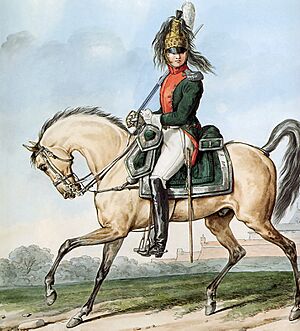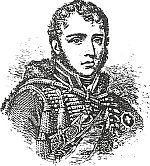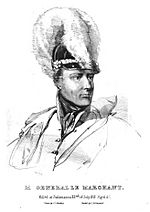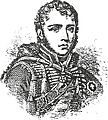Battle of Villagarcia facts for kids
Quick facts for kids Battle of Villagarcia |
|||||||
|---|---|---|---|---|---|---|---|
| Part of the Peninsular War | |||||||
 In the right foreground British heavy dragoons of Le Marchant's brigade are depicted charging during the Battle of Salamanca. They had done the same a few months earlier at Villagarcia. |
|||||||
|
|||||||
| Belligerents | |||||||
| Commanders and leaders | |||||||
|
|||||||
| Strength | |||||||
| 1,100 | 1,400 | ||||||
| Casualties and losses | |||||||
| 53 killed or wounded 136 captured |
51 killed or wounded | ||||||
The Battle of Villagarcia (also known as the Battle of Llerena) happened on April 11, 1812. It was a fight between British and French cavalry during the Peninsular War in Spain. British cavalry, led by General Stapleton Cotton, defeated a French cavalry force. The French were commanded by General Charles Lallemand.
General Cotton planned to trap the French cavalry. They were far away from their main army. His plan was to attack from the front and the sides at the same time. However, the front attack started too early. This almost ruined the plan. Luckily, General John Le Marchant and his troops arrived just in time. They attacked the French from their left side and saved the day.
Contents
Why the Battle of Villagarcia Happened
A few days before this battle, on April 6, 1812, the French fortress city of Badajoz had fallen. This was a big win for the British and Portuguese armies. Their leader, Wellington, decided it was time to go on the attack.
Before moving his main army north, Wellington sent a large group of cavalry south. This group was led by General Sir Rowland Hill. Their job was to push the French army, led by Marshal Jean-de-Dieu Soult, back into southern Spain. Marshal Soult had tried to help Badajoz but failed.
General Hill's cavalry, under General Stapleton Cotton, was pushing hard against the French. These French forces were still in the region of Extremadura.
Who Fought in the Battle of Villagarcia?
The British cavalry force was led by General Stapleton Cotton. It included several brigades (groups of regiments).
- John Le Marchant's heavy brigade had the 3rd and 4th Dragoons and the 5th Dragoon Guards.
- John Slade's heavy brigade had the 1st Dragoons and the 3rd and 4th Dragoon Guards.
- Frederick Ponsonby's light brigade had the 12th, 14th, and 16th Light Dragoons.
Only Ponsonby's brigade and the 5th Dragoon Guards were directly involved in the main fighting.
The French cavalry was part of a larger force. It was led by General François "Charles" Lallemand. His force included the 2nd Hussars and the 17th and 27th Dragoons.
The Battle Unfolds
On the evening of April 10, 1812, General Cotton climbed a church tower in Bienvenida. He saw that the French were in Llerena. He also noticed many French cavalry troops closer to him, near Villagarcia. Cotton decided to try and trap these French cavalry with his larger force.
During the night, he sent Ponsonby with two regiments to check out the Villagarcia area. Le Marchant was sent on a long, winding march. His goal was to get behind the French and cut off their escape. Slade was also told to bring his brigade to Bienvenida, but he was slow to move. Cotton kept one regiment, the 16th Light Dragoons, as a backup.
Cotton soon realized that Ponsonby's troops might alert the French too early. He sent a messenger to stop them. But the order arrived too late.
Two groups of British light cavalry had pushed French guards out of Villagarcia. But around dawn, they ran into the full French cavalry force. The French chased them back. Ponsonby's two regiments were now facing three strong French regiments. They had to slowly retreat while fighting against many more enemies.
Meanwhile, Le Marchant had been marching his brigade through the night. The ground was difficult. Le Marchant and the 5th Dragoon Guards got ahead of the rest of his brigade. He saw the French cavalry pushing Ponsonby's troops back towards a narrow ditch with stone walls. Le Marchant knew he had to charge right away. If he waited, Ponsonby's soldiers would be trapped.
It is said that General Lallemand saw some red-coated figures in the woods to his left. He rode to warn General Peyremmont, who was leading the 2nd Hussars. But Peyremmont didn't believe Lallemand. He thought the British were just a small group who were lost.
At this moment, the battle changed completely. Le Marchant led his dragoon guards out of the woods. They quickly formed their lines and charged. The 5th Dragoon Guards attacked the French from their left side. This side was open and deep, and the attack hit them hard. At the same time, the 16th Light Dragoons, led by Cotton, appeared on Ponsonby's right. They jumped over a stone wall and charged too. The French cavalry were instantly confused and quickly broke apart.
The British chased the French, causing more damage and taking prisoners. They chased them all the way back to Llerena, where most of the French army was gathered. The French tried to regroup at a ditch, but the 16th Light Dragoons went around them. The French were forced to run away again. A few hours later, the French left Llerena and continued their retreat out of Extremadura.
What Was the Outcome?
The Battle of Villagarcia was a clear British victory.
- The French lost 53 soldiers killed or wounded. They also had 136 soldiers captured, including 4 officers.
- The British lost 51 soldiers killed or wounded.
This battle forced the French to leave the region of Extremadura.
General Cotton showed good leadership by planning to trap the French. However, his plan relied on perfect timing, which is very hard in battle. It almost went wrong when his central force attacked too soon. But Cotton was flexible. He changed his plan when the original one didn't work. General Slade's brigade, unfortunately, never showed up at all.
General Le Marchant proved himself a very skilled cavalry commander. This was his first big battle as a general. He was already known for his military ideas and teaching.
Images for kids







